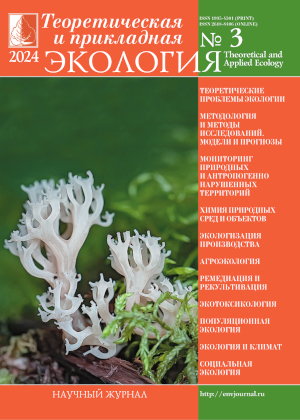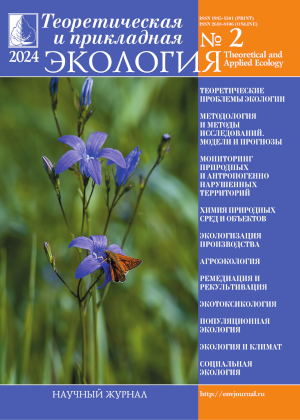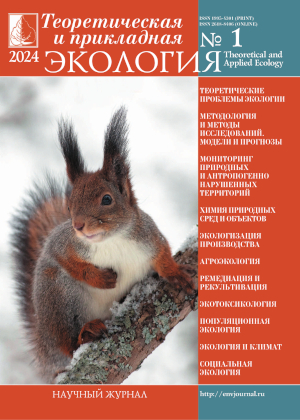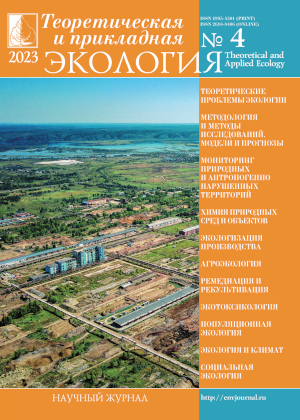 ISSN 1995-4301
ISSN 1995-4301(Print)
ISSN 2618-8406
(Online)
Online version of the journal
|
Antibiotic ciprofloxacin in water and soil media: reaction of microalgae |
||||
| A.D. Batakov, A.P. Kiryushina, D.N. Matorin, V.A. Terekhova | ||||
| Section: Ecotoxicology |
||||
| Pharmaceuticals and antibiotics in the environment are of increasing concern due to the impact on representatives of all links in the food chain of natural ecosystems. The effect of the widespread antibiotic ciprofloxacin (Cip) on the green protococcal microalgae Scenedesmus quadricauda and Chlorella vulgaris in water and aqueous soil extracts (artificial standard soil, technosoil, soddy-podzolic soil) was studied in model experiments. Fluorescent parameters were assessed by two different methods (Fluorat 02-5M and Water-PAM devices). The phenomenon of hormesis was observed at low antibiotic concentrations of 5 and 10 mg/L. A decrease in the photosynthetic activity of algae was recorded at an increase of Cip content from 20 to 50 mg/L. A comparison was made of the median (average effective) concentration of the EC50 antibiotic, which suppresses the fluorescent characteristics of microalgae by 50% on 3 days of exposure in different media. The decrease in the toxicity of the studied dose of Cip (300 mg/L) in a number of studied objects can be represented as follows: water > technosoil > artificial standard soil > soddy-podzolic soil. It reflects the percentage of inhibition of the test function relative to the control (samples without antibiotic) by 91.5, 80.0, 62.5, and 60.0% respectively. In the soil matrix, the inhibitory effect of the antibiotic is less pronounced (by 10–30%), probably due to the protective properties of humic substances that adsorb the antibiotic or its metabolites. | ||||
| Keywords: algotesting, ecotoxicity, antibiotic ciprofloxacin, water, soil, humic substances |
||||
| Article published in number 2 for 2024 DOI: 10.25750/1995-4301-2024-2-143-150 |
||||
|
||||
Functional characteristics of Нeracleum sosnowskyi Manden. terminal buds during preparation for overwintering |
||||
| S.P. Maslova, O.V. Dymova, R.V. Malyshev, I.V. Dalke | ||||
| Section: Population ecology |
||||
| Based on the study of the physiological and biochemical characteristics of Heracleum sosnowskyi buds we identified functional adaptations during the preparation of plants for overwintering. The freezing point of water in the buds tissues was –12 оC in October, while maintaining high water content (more than 80%). Buds has a relatively high efficiency of respiration at low positive temperatures (2–5 оC), which favors morphogenesis processes in the shoot vegetative cone in autumn. During the preparation for overwintering the buds accumulated osmoregulators – soluble sugars, free amino acids, including proline. A relatively high level of cytokinin growth hormones was found in the buds tissues. This contributes to morphogenesis processes and increases plant cold tolerance. We found that in December the abscisic acid (a growth inhibitor and resting hormone) content increases and the level of cytokinins decrease. Heracleum sosnowskyi formed buds differing in the photosynthetic pigments content. Buds with green scale leaves accumulated the greatest amount of chlorophylls and carotenoids, while those with red-brown and yellow ones accumulated the least. The carotenoids accumulation in the green buds tissues protects the formed photosynthetic apparatus at low positive temperatures in autumn. The results on the functional state of H. sosnowskyi terminal buds in natural populations indicate the absence of deep dormancy in plants, and morphogenesis processes in meristems tissues are limited by winter temperatures. | ||||
| Keywords: Heracleum sosnowskyi, buds, respiration, non-structural carbohydrates, amino acids, photosynthetic pigments, phytohormones, overwintering |
||||
| Link | ||||
| Article published in number 2 for 2024 DOI: 10.25750/1995-4301-2024-2-185-192 |
||||
|
||||
Bacteria-destructors with growth-stimulating properties for use in ecological biotechnology |
||||
| T.Yu. Korshunova, E.V. Kuzina, S.R. Mukhamatdyarova, Yu.Yu. Sharipova, M.G. Iskuzhina | ||||
| Section: Remediation and rehabilitation |
||||
| A topical research trend in ecological biotechnology is the search and study of microorganisms-destructor resistant to additional pollutants and growth-stimulating to remediant-plants. Four strains of hydrocarbon-oxidizing microorganisms isolated from soil samples were identified on the basis of cultural-morphological, physiological-biochemical properties and a comparative analysis of the gene encoding 16S rRNA. The bacteria Acinetobacter calcoaceticus UOM 22 and UOM 29, A. courvalinii UOM 35 showed a significant degree of oil biodegradation in a liquid medium at 24 and 8 °C (93.0–95.6% and 78.4–81.1%, respectively). In the same conditions these indicators were 44.8 and 33.7%, respectively for strain Rhodococcus erythropolis UOM 33. All microorganisms grew in the presence of aromatic hydrocarbons (including polycyclic hydrocarbons), were resistant to NaCl (5–7%) and lead ions (1.00–1.25 g/L). They were capable of nitrogen fixation and inorganic phosphate dissolution, indole-3-acetic acid synthesis (150–1416 ng/ml of culture liquid) and hydrolytic enzyme lipase production. We found that A. calcoaceticus UOM 22 and A. courvalinii UOM 35 strains increased the barley seeds germination by 8.6 and 10.5%, as well as A. calcoaceticus UOM 29 and A. courvalinii UOM 35 stimulated the barley root growth by 16.3 and 18.1% respectively. The results of the experiments indicate the possibility of using A. calcoaceticus UOM 22 and UOM 29, and A. courvalinii UOM 35 strains for cleaning oil-contaminated soils, including in combination with remediant-plants. | ||||
| Keywords: oil pollution, oil degrading bacteria, sodium chloride, heavy metals, plant growth stimulation, barley |
||||
| Article published in number 2 for 2024 DOI: 10.25750/1995-4301-2024-2-117-124 |
||||
|
||||
Adsorption recovery of amines from water solutions |
||||
| I.E. Targanov, A.L. Gakiev, А.А. Кadirbekov, I.D. Troshkina, N.А. Bektenov, А.G. Cherednichenko | ||||
| Section: Ecologization of industry |
||||
| Aquatic biological resources are an important part of the ecosystems of our planet, since they are involved in economic turnover as a source of food. The composition of water, including waste water from enterprises, has a direct impact on the state of aquatic biological resources. To extract and concentrate metals from solutions, hydrometallurgical processes are used – extraction and sorption. Their implementation is possible with the use of special substances – extractants and in a number of processes – sorption materials (Solvent Impregnated Resins (SIR’s) and Levextrel’s) with a mobile phase of the extractant, combining the properties of sorbents and extractants. Despite the advantages of the latter, such as high kinetic parameters, lack of swelling and high values of mechanical strength, they are characterized by the disadvantages of extraction methods – the entrainment of the extractant into the aqueous phase in dissolved and emulsion forms. Under static conditions, the possibility of purification of aqueous solutions containing primary or tertiary amine by adsorption on carbon materials (activated carbon NWC, carbon NWC-T modified with carbon nanotubes, CS-PTFE modified with polytetrafluoroethylene), as well as on styrene-divinylbenzene nonionic copolymer Porolas-T and a natural shell rock adsorbent was studied. The kinetics of adsorption of аmines Primene-JMT and TOA from aqueous solutions by these adsorbents has been studied by the method of a limited volume of solution. Of the known pseudo-first order, pseudo-second order and Elovich models, the pseudo-second order model describes kinetic data more adequately (R2>0.99). The values of the distribution coefficients and the rate constants of adsorption of Primene-JMT and TOA are determined. A block diagram of adsorption purification of aqueous solutions from amines is proposed, the implementation of which will reduce the toxicity of waste solutions and return some of the expensive extractant to circulation. | ||||
| Keywords: adsorption, amines, coal, synthetic polymer sorbent, modified coal, shell rock, distribution coefficient, velocity constant, block diagram |
||||
| Article published in number 2 for 2024 DOI: 10.25750/1995-4301-2024-2-091-100 |
||||
|
||||
Effect of phosphorus-containing pesticides on the enzymatic activity and multiple forms of acid phosphatase of river snail (Viviparus viviparus L.) |
||||
| E.A. Tishina, T.S. Droganova, L.V. Polikarpova, N.V. Vasiliev | ||||
| Section: Ecotoxicology |
||||
| Organophosphate pesticides are used in agriculture and for treating landscape and park areas due to their high efficiency and economic availability, and therefore they are potential toxicants in water bodies. Broad-spectrum systemic herbicide (Glyphosate) and an organophosphorus insecticide (Malathion) have been studied against the freshwater mollusks (Viviparus viviparus L.), widespread in permanent water bodies of the European part of Russia and Siberia. Changes in the activity and composition of multiple forms of acid phosphatase (AcP) were revealed in the hepatopan creas of mollusks under the influence of high doses of glyphosate and malathion in an acute toxicological experiment (96 hours). In both cases, an increase in enzyme activity is observed, but the cholinomimetic malathion is significantly more active than glyphosate, the neurotropic activity of which is unknown. It was shown that the increase in activity in the experimental groups of mollusks is associated with the appearance of new multiple forms of acid phosphatase, which persist throughout the experiment. Multiple form of AсP with low relative electrophoretic mobility revealed as an effect of glyphosate and malathion. In addition, in mollusks exposed to malathion, a multiple form of the enzyme with an average electrophoretic mobility was detected. The composition of multiple forms of acid phosphatase in mollusks of the control group did not change during the exposure. The results indicate the formation of nonspecific adaptations in response to organophosphate pesticides and confirm that acid phosphatase can be an indicator of toxic effects in environmental and biochemical monitoring of freshwater pollution. | ||||
| Keywords: ecological and biochemical monitoring, hydrobionts, river snail, toxic effect, glyphosate, malathion, enzymes, acid phosphatase, multiple forms of the enzyme |
||||
   |
||||
| Article published in number 2 for 2024 DOI: 10.25750/1995-4301-2024-2-151-158 |
||||
|
||||
Fauna and bird population of the mountainous areas of the Varangerfjord southern coast |
||||
| I.V. Zatsarinny, U.Y. Shavrina, E.V. Valova, O.V. Natalskaya | ||||
| Section: Ecology and climate change |
||||
| The article presents data from field studies of the fauna and bird population of mountainous areas of the Varangerfjord southern coast. This area has erspectives to be included in the boundaries of the projected “Voryema” Federal Reserve. We carried field studies during the 2019–2021 breeding period in the northwestern part of the Pechengsky district of the Murmansk region. In the course of the work, we surveyed mountainous areas from areas adjacent to the Voryema River valley to areas near the iinahamari settlement. The total length of survey routes was 81.8 km. Analysis of the received field materials shows that at least 53 bird species occur in the breeding season. Tundra and rocky areas are breeding sites for skuas, gulls, loons, and a number of sandpipers’ and ducks’ species. The combination of different habitats creates the possibility of the presence of four species of pipits on this territory at once. Therefore, this territory can be a good model for studying the effects of climate change on a number of closely related species living together. In general, the results of the study show that the surveyed territories of the mountainous areas of the Varangerfjord southern coast are promising for inclusion in the boundaries of the projected Voryema Federal Reserve. They have a characteristic bird population structure and serve as breeding grounds for a number of rare species (whooper swan, whooper, golden eagle, white-tailed eagle, kestrel, white-throated thrush). | ||||
| Keywords: ornithofauna, Murmansk region, the projected Voryema Reserve |
||||
| Article published in number 2 for 2024 DOI: 10.25750/1995-4301-2024-2-211-218 |
||||
|
||||
Transformation of soil macrofauna in the first year after deforestation |
||||
| A.A. Ditts, T.N. Konakova, A.A. Fateeva | ||||
| Section: Monitoring of natural and anthropogenically disturbed areas |
||||
| Soil macrofauna of primary forests of the middle taiga is characterized by high abundance (94.6–146.6 ind./m2), taxonomic richness (10–14 taxa), dominance of Diptera and Cantharidae larvae, similarity of fauna composition (J=0.60–0.65), with a ratio of detritivores and predators equal to 1:1, aggregated or random horizontal distribution. The total density of invertebrates sharply decreases (4.5–26.8 ind./m2) in the first year after deforestation. Some taxa are eliminated from the fauna, 4–7 taxa are remained. The ratio of trophic groups is changed. The distribution of invertebrates in space is disturbed. Soil macrofauna of clear-cutting areas (CCA) retains a taxonomic structure close to the control sites (C). The taxonomic and trophic structure of soil macrofauna is more disturbed on the logging corridors (LC) with three (3LC) and ten (10LC) penetrations of aggregate equipment, recultivated (RLC) and main (MLC) logging corridors. Thus, the density of Diptera larvae is high on the logging corridors. The above are temporary r-strategists characteristic for the disturbed environment. And the ratio of detritivores and predators on the technological sites “C – CCA – 3LC – 10LС – RLC – MLC” is 1:1 – 3:1 – 7:1 – 10:1 – 13:1 – 15:1. A trend towards an increase in the density of detritivores on the recultivated (RLC) and main (MLC) logging corridors was noted. The decrease of the total density of macrofauna and the declining of systematic groups of the clear-cutting areas is not so significant due to the fact that the litter on these sites is almost completely preserved after felling. The low diversity of soil macrofauna on the logging corridors can be explained by a change in the natural conditions for the existence of invertebrates due to the compaction of the upper soil horizons, the partial disappearance of the litter, the appearance of a mineralized soil layer as top horizon, and a rapid change in humidity. Significant changes in the abundance, composition, and ratio of trophic groups of invertebrates indicate the collapse of soil macrofauna, the loss of important groups of destructors and predators from food webs, and a decrease in the quality of their functions at the initial stage of restorative succession, in the first year after deforestation. | ||||
| Keywords: soil macrofauna, Lumbricidae, Lithobiidae, Staphylinidae, Elateridae, deforestation, forest, catena, Komi Republic |
||||
| Article published in number 2 for 2024 DOI: 10.25750/1995-4301-2024-2-048-056 |
||||
|
||||
Geochemical characteristics of the Lake Chvanikha, the natural monument of the Kirov region |
||||
| O.A. Lipatnikova, T.N. Lubkova, O.V. Solodyankina | ||||
| Section: Chemistry of natural environments and objects |
||||
| The article presents characteristics of the abiotic components (water and bottom sediments) of the karst Lake Chvanikha. The lake is located in the Nolinsky district of the Kirov region and has the status of the hydrological natural monument of regional significance. The results are based on precision analytic data (obtained by ICP-MS, X-ray fluorescence analysis, chemical methods, photometry, etc.) and on thermodynamic calculations (Visual-MINTEQ. ver. 3.1). The composition of the waters indirectly indicates to the development of carbonate karst (mainly the dissolution of dolomite) in the upper rock strata at the base of the lake basin and to the presence of minor gypsum interlayers at depth. The concentrations of dissolved forms of trace elements do not exceed the MPCs of harmful substances in the waters of fishery basins and generally corresponds to the average contents in the rivers of the world. The base forms of trace elements in water are their free ions (for Sr, Ba, Fe, Mn, Zn, Ni, Co, Cd) and carbonate complexes (for Pb and Cu). The bottom sediments are represented of fine quartz sands, which overlap the karst rocks. In the absence of a significant technogenic impact, the poor grade of sand’s ferruginization determines low contents of potential pollutants (Cu, Zn, Pb, Cd, As, Mo, Ni, Cr, V), typical for quartz sands. | ||||
| Keywords: Lake Chvanikha, karst sinkholes, macrocomponent composition of water, trace elements, thermodynamic calculations, bottom sediments |
||||
| Article published in number 2 for 2024 DOI: 10.25750/1995-4301-2024-2-082-090 |
||||
|
||||
Study of adsorption separation of gas mixtures under non-stationary conditions |
||||
| F.V. Yusubov, I.A. Aliyev, S.N. Guliyev | ||||
| Section: Ecologization of industry |
||||
| The influence of the initial concentration, rate and temperature of adsorption on the adsorption separation of gas mixtures (CO2, CH4, N2, H2S) is investigated. Components: N2 – 5%, H2S – 5%, CO2 – 5% and CH4 – 85%. And as an adsorbent granule of clinoptilolite of irregular shape were used. Isothermal adsorption of CO2 was obtained at different temperatures (293, 313, and 323 K). The obtained isotherms of CO2 adsorption showed that with an increase in temperature, the adsorption of CO2 decreased. The type of isotherms corresponds to Langmuir. The output curves of gas mixture adsorption depending on the gas flow rate and various main components of CO2 were also experimentally studied. The output curves of the adsorption of the CO2 component were studied at various gas flow rates of 20, 50, and 80 mL/min. Equilibrium time increases with a decrease in the gas flow rate. Output curves were also obtained depending on the initial CO2 concentrations of 5%, 10% and 20%. It was determined that with a decrease in the initial concentration of CO2, the equilibrium time also increases. Gas mixture components sorbed downwards: H2S→CO2→CH4→N2. The resulting system of model equations describing the adsorption separation of gas mixtures in a fixed adsorbent layer represents a complete mathematical model of the process under unsteady conditions. The obtained regularities of the process of adsorption of gas mixtures testify to the fact that the process takes place under non-stationary conditions. The proposed models for the optimal design of industrial absorbers can be used for adsorption separation of gas mixtures in the conditions of their unsteady flow. | ||||
| Keywords: adsorption, gas mixture, non-stationary, mathematical model |
||||
| Article published in number 2 for 2024 DOI: 10.25750/1995-4301-2024-2-101-107 |
||||
|
||||
Drosophila melanogaster as an in vivo model for assessing the cytogenetic effects of low-intensity ionizing radiation |
||||
| E.A. Yushkova | ||||
| Section: Monitoring of natural and anthropogenically disturbed areas |
||||
| The most important target of radiation damage is the cell nucleus. Structural and functional changes occurring in the nucleus under the influence of ionizing radiation affect the development of different biological effects at the cellular and organismal levels. In the present study, the Comet assay was used which makes it possible to assess the complex of DNA damage in different somatic cells of the body. The specificity of the cytogenetic effect of irradiation in low doses in Drosophila melanogaster has been established. The observed reactions depended not only on the irradiation dose and genotype but also on the type of DNA damage and tissue. In general, neuroblasts of individuals with low synthesis of cytoplasmic superoxide dismutase (sodn1/+) showed the highest sensitivity to irradiation in low doses. With an increase in the dose of ionizing radiation, the frequency of alkali-labile sites and DNA single-strand breaks in sodn1-genotype cells increased. The repair mutant genotypes, on the contrary, had radiosensitive traits exclusively at the level of DNA double-strand breaks. To a greater extent, an increase in the yield of radiation-induced DNA damage of this type was registered in cells of the imaginal disks of individuals with defect in the mechanisms of DNA double-strand break repair (okrA17-11/+), postreplicative repair, and meiotic recombination (mei-41D5/+). The genetically unstable strains used in the work have radiosensitive features which makes them convenient models for assessing the radioecological situation in the environment. | ||||
| Keywords: Drosophila melanogaster, irradiation, cytogenetic effects, mutations in genes for repair and antioxidant protection |
||||
| Article published in number 2 for 2024 DOI: 10.25750/1995-4301-2024-2-057-062 |
||||
|
Pages: previous 1 2 3
 |
 |
 |
 |
 |
 |
 |
 |
 |
 |
 |
 |
 |
 |
 |
|
|||||
|
36, Moskovskya street, Kirov, 610000, Editorial Board "Theoretical and Applied Ecology." Phone/fax: (8332) 37-02-77 e-mail: envjournal@vyatsu.ru The journal was founded in 2007 |
||||||




 Select viewing options
Select viewing options